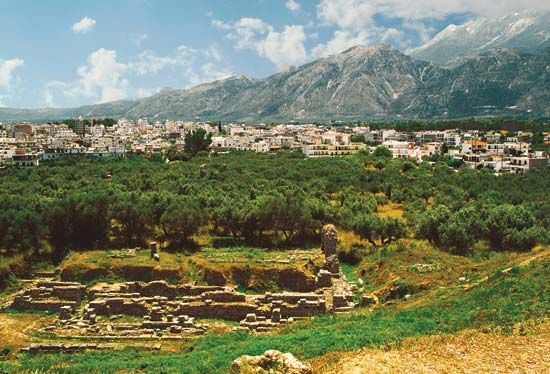Sparta
- Modern Greek:
- Spartí
- Historically:
- Lacedaemon
- Key People:
- Thucydides
- Xenophon
- Epaminondas
- Agesilaus II
- Cleomenes III
- Related Topics:
- Peloponnesian League
- Arcadian League
- Related Places:
- Greece
- ancient Greece
- Laconia
What is the ancient name of Sparta?
Which battle established Sparta as the most powerful state in Greece?
When was present-day Sparta established?
Who was Leonidas?
Sparta, ancient capital of the Laconia district of the southeastern Peloponnese, southwestern Greece. Along with the surrounding area, it forms the perifereiakí enótita (regional unit) of Laconia (Modern Greek: Lakonía) within the Peloponnese (Pelopónnisos) periféreia (region). The city lies on the right bank of the Evrótas Potamós (river). The sparsity of ruins from antiquity around the modern city reflects the austerity of the military oligarchy that ruled the Spartan city-state from the 6th to the 2nd century bce.
Reputedly founded in the 9th century bce with a rigid oligarchic constitution, the state of Sparta for centuries retained as lifetime corulers two kings who arbitrated in time of war. In time of peace, power was concentrated in a Senate of 30 members. Between the 8th and 5th century bce, Sparta subdued Messenia, reducing the inhabitants to serflike status. From the 5th century the ruling class of Sparta devoted itself to war and diplomacy, deliberately neglecting the arts, philosophy, and literature, and forged the most powerful army standing in Greece.
Sparta’s single-minded dedication to rule by a militarized oligarchy precluded any hope of a political unification of Classical Greece, but it performed a great service in 480 bce by its heroic stand at Thermopylae and its subsequent leadership in the Greco-Persian wars. The Battle of Salamis (480) revealed the magnitude of Athenian naval power and set in motion the deadly struggle between the two powers that ended in Athenian defeat at the close of the Peloponnesian War in 404 and the emergence of Sparta as the most powerful state in Greece. In the Corinthian War (395–387) Sparta had two land victories over Athenian allied states and a severe naval defeat at Cnidus by a combined Athenian and Persian fleet. Sparta’s involvement in Persian civil wars in Asia Minor under Agesilaus II (ruled 399–360) and the subsequent Spartan occupation (382) of the Theban citadel, Cadmea, overextended Spartan power and exposed the state to defeat at Leuctra (371) by the Theban Epaminondas, who went on to liberate Messenia. A century-long decline followed.

Sparta’s continued agitation spurred Rome’s war on the Achaeans (146) and the Roman conquest of the Peloponnese. In 396 ce the modest city was destroyed by the Visigoths. The Byzantines repopulated the site and gave it the ancient Homeric name Lacedaemon. After 1204 the Franks built a new fortress city, Mistra, on a spur of the Taygetus range southwest of Sparta; after 1259 Mistra was capital of the Despotate of Morea (i.e., the Peloponnese) and flourished for about two centuries. From 1460 until the War of Greek Independence (1821–29), except for a Venetian interlude, the region was under Turkish rule.
The present-day city was built in 1834 on the ancient site; it is called Néa (New) Spartí locally to distinguish it from the ruins that were excavated in 1906–10 and 1924–29. A small commercial and industrial centre of the European plain, the city trades in citrus fruits and olive oil. As in antiquity, it is served by the small port of Githion (Yíthion), 28 miles (45 km) southeast, to which it is linked by a paved road. Pop. (2001) city, 17,503; (2011) 16,239.
















